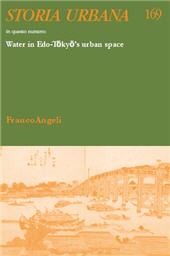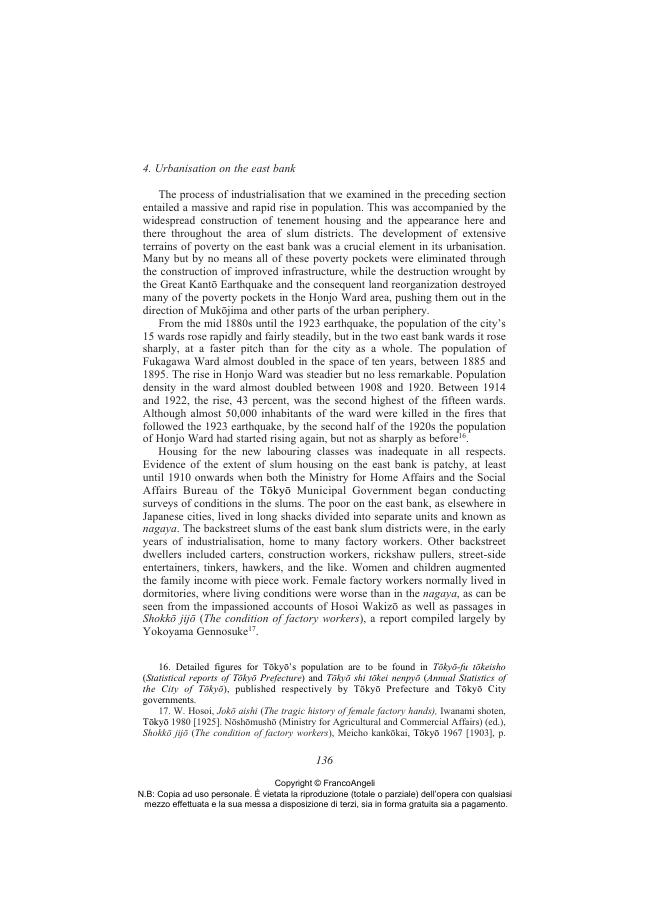Reflecting the Changing Landscapes of Edo-Tōkyō's East Bank Waterways
125-146 p.
It is often difficult today to appreciate the important role that waterways played in the development of EdoTōkyō. For most of the city's history, however, they have been fundamental to its economic prosperity and its cultural landscape. In this chapter, I focus on the city's main river, the Sumida, and the waterways that drain into it from its east bank, away from the centre of the city. During the Edo period, the east bank presented space for urban expansion. Its many waterways provided extra capacity for the offloading of goods and provisions and the establishment of marketplaces. Indeed, the ubiquity of water and waterways meant that the east bank became the principal site of industrialisation and the problems that accompanied it. Here I take a longitudinal look at the Sumida and the east bank's waterways. I start with a brief introduction to water and land in the city's early years.
The bulk of this chapter explores the development of waterways and activities along their banks in the XIX and early XX centuries, bridging the change from shogunal to imperial rule. This long temporal span throws a number of changes into relief. The first is the nature of the documentary material, whose nature and idiom changes radically through this period. Second is the process of urbanisation and later of industrialisation that occurred as the east bank became ever more densely populated. The third relates to the waterways themselves, vital to the provisioning of the city, arena of recreation but also source of pollution. [Publisher's text].
È spesso difficile apprezzare oggi l'importante funzione svolta dai corsi d'acqua nello sviluppo di EdoÂÂTōkyō. Per gran parte della storia della città, tuttavia, essi sono stati fondamentali per la sua prosperità economica e per il suo panorama culturale. In questo articolo, ci si concentrerà sul fiume principale della città, il Sumida, e sui corsi d'acqua che vi affluiscono dalla sua sponda orientale, lontano dal centro della città. Durante il periodo Edo, la sponda orientale fornì spazio per l'espansione urbana. I suoi numerosi corsi d'acqua offrivano enormi possibilità per lo scarico di merci e provviste e per la creazione di mercati. L'ubiquità dell'acqua e dei corsi d'acqua fece sì che la sponda orientale diventasse in seguito il principale sito di industrializzazione. Qui si fornirà una visione in senso longitudinale del Sumida e dei corsi d'acqua della sponda orientale.
Dopo una breve introduzione sull'acqua e il territorio nei primi anni della città, si esplorerà lo sviluppo dei corsi d'acqua e delle attività lungo le loro sponde nel XIX e all'inizio del XX secolo, ovvero nel corso del passaggio dal governo shogunale a quello imperiale. Questo lungo arco temporale evidenzia una serie di cambiamenti. Il primo è legato alla tipologia del materiale documentario, la cui natura e il cui linguagÂÂgio cambiano radicalmente in questo periodo. Il secondo è relativo al processo di urbanizzazione e alla successiva industrializzazione che si verificarono quando la sponda orientale divenne sempre più densamente popolata. Il terzo riguarda i corsi d'acqua stessi, vitali per l'approvvigionamento della città, arena di svago ma anche fonte di inÂÂ quinamento. [Testo dell'editore].
-
Articoli dello stesso fascicolo (disponibili singolarmente)
-
Informazioni
Codice DOI: 10.3280/SU2021-169006
ISSN: 1972-5523
PAROLE CHIAVE
- EdoÂÂTōkyō Corsi d'acqua Riva orientale del Sumida Urbanizzazione Industrializzazione
- EdoTōkyō, waterways, Sumida's east bank, urbanisation, industrialisation



